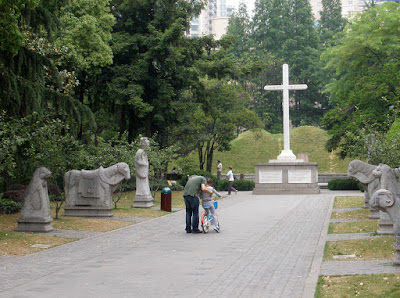Saturday, May 14, 2011
We have been told to soon expect three weeks of solid rain, and we have already planned to visit museums during that time. However, the weather continues to stay dry, if not sunny, and so we plod ahead with fair weather activities which require walking.
Today we walked in our own neighborhood of Xujiahui, which our Chinese language teacher explained meant the home of the Xu family. "Jia hui" is used for "to go home."
Guangqi Park:
with its rockery:and bridge:
is the site of Xu Guangqi's tomb:
A girl is learning to ride a bicycle:
Note the cross in front of the tomb:
Xu Guangqi was converted to Roman Catholicism by an Italian Jesuit priest, thus upon Xu's death, he donated land to the Jesuits to build a church, school, and observatory. (More on Xu Guangqi at: http://www.cnngo.com/shanghai/play/historic-shanghai/xu-guangqi-shanghais-holy-son-617613)
Eventually the Jesuits built this brick Gothic church, St. Ignatius Cathedral, completed in 1910:
On Saturdays, parks and landmark sites are busy with couples having their wedding photos taken. It's a major business. We don't know if it is before or after the wedding, but it appears that this is one day's activity. The bride often is wearing sneakers and pants under the dress.
The Shanghai Diocesan Office is almost as decorated as the cathedral!
St. Ignatius lost its spires and stained glass windows during the Cultural Revolution, and the spires were rebuilt in slightly darker brick.
The poses they make these couples assume!
Gargoyles:
A bit farther is the Longhua Temple. These lions stand at the original entrance:
The octagonal Longhua Pagoda is the oldest one in Shanghai, with its foundation and brick core from the year 977:
Only fragile woodwork has been replaced. It is not open to the public, and it appears it is tilting:
The entry gate to Longhua Temple:
Maitreya Hall:
The Maitreya Buddha:
A lotus paver:
This man was waving his incense sticks so quickly that they were flaming:
This monk is quieter in his contemplation:
The Hall of the Heavenly Kings:
The Grand Hall:
A stone relief carving of elephants:
Buddha sitting on a lotus throne, with two disciples:
Note the interior dome which is unique.
The Amitabha Buddha, the Buddha of Infinite Light and blue hair:
A stone relief carving of a dragon:
The typical curved roof corners in Southern Song Dynasty architecture:
A side hall with 500 Arhats:
We had lunch at a vegetarian buffet restaurant at the temple.
The vast grounds behind the temple were used for public executions in the 19th century. The Nationalist government had a prison here, and thousands of suspected communists were executed. During the Second Sino-Japanese war, the Japanese maintained a civilian internment camp here, which was portrayed in the movie, The Empire of the Sun. Now it is the Longhua Cemetery for the Revolutionary Martyrs, more of a memorial park with a museum.
Kent went alone to visit, because I was stopped by the Army guard at the gate for wearing improper shoes (I was wearing flipflops).
Monumental sculptures:
Memorial Hall:
A sign proclaiming something like "Red heart fresh blood for the people:"
Sunday, May 15, 2011
Today it was sunny! Headed in the opposite direction today.
A dolphin fountain:
We have seen only one fountain that actually had water in it in Shanghai.
Back to the French Concession. Mediterranean-influenced architecture?
The famous Normandie Apartments, or Wukang Building:
Built in 1924, designed by Hungarian Laszlo Hudec, in Renaissance style. This building has arcades - a covered sidewalk inside the arches along the street.
Shaded street:
Song Qingling's former residence and memorial museum:
Song Qingling was an amazing woman, whether or not you agree with her politics. Actually, she was not as political as much as she was a peace and unity activist. She married Sun Yatsen in 1915, and he died in 1925 (being 26 years older than she), so she was a part of the Nationalist government. While her sister married Chiang Kai Shek and fled to Taiwan in 1949, Song Qingling remained, and in fact was given this house by the Communist Party.
Here are her two limousines, one made in China and the other a gift from Stalin in 1952.
Song Qingling's dove cote:
She liked to use doves as a sign of peace.Ancient oleanders:
Potting shed:
Back yard surrounded by 100-year old cinnamon camphor trees:
The gardener gives scale:
The gardener is being very meticulous:
There is an A-rated camellia in the back right corner:
Kent is at the front door of the villa which was built in 1920 in western style for either a German or Greek ship owner:
The residence is dominated by trees:
Heading back home, we passed the 1934 art deco Hengshan Picardie Hotel:
And walked through Xujiahui Park, with the Fountain of Hope that was a gift from the city of Marseilles:
The park was partially built on the site of the Ta Chung Hua Rubber Factory, leaving one chimney:
Black swans:
Lotus pond:
Red-eared slider:
View back at the park:
Sing-along in the park:

























































1 comment:
I've been reading your blog for the past few days, love it. I've gotta say you have a Hong Kongish blogging style with lots of lovely images.
The preparation of Chinese weddings are normally planned many months ahead where at least a full day is dedicated for photo taking. So, most if not all those 'married' couples we see busy having their photos captured are actually not married, yet.
Post a Comment